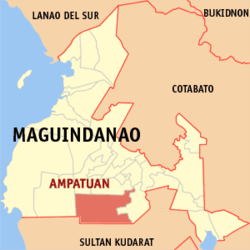Ampatuan, Maguindanao
| Ampatuan | |
|---|---|
| Municipality | |
| Municipality of Ampatuan | |
 Map of Maguindanao with Ampatuan highlighted | |
.svg.png) Ampatuan Location within the Philippines | |
| Coordinates: 6°52′01″N 124°28′01″E / 6.8669°N 124.4669°ECoordinates: 6°52′01″N 124°28′01″E / 6.8669°N 124.4669°E | |
| Country |
|
| Region | Autonomous Region in Muslim Mindanao (ARMM) |
| Province | Maguindanao |
| District | 2nd District |
| Barangays | 11 (see Barangays) |
| Government [1] | |
| • Type | Sangguniang Bayan |
| • Mayor | Datu Rasul Sangki |
| • Electorate | 11,630 voters (2016) |
| Area [2] | |
| • Total | 255.40 km2 (98.61 sq mi) |
| Population (2015 census)[3] | |
| • Total | 24,801 |
| • Density | 97/km2 (250/sq mi) |
| Time zone | UTC+8 (PST) |
| ZIP code | 9609 |
| PSGC | 153801000 |
| IDD : area code | +63 (0)64 |
| Climate type | Tropical climate |
| Income class | 4th municipal income class |
| Revenue (₱) | 79,313,461.41 (2016) |
| Native languages |
Maguindanao language Tagalog |
| Website |
www |
Ampatuan, officially the Municipality of Ampatuan, is a 4th class municipality in the province of Maguindanao, Philippines. According to the 2015 census, it has a population of 24,801 people.[3]
Barangays
Ampatuan is politically subdivided into 11 barangays.[4]
- Dicalongan (Poblacion)
- Kakal
- Kamasi
- Kapilpilaan
- Kauran
- Malatimon
- Matagabong
- Saniag
- Tomicor
- Tubak
- Salman
History
Ampatuan was created out of 23 barrios of Datu Piang on 21 June 1959 by Republic Act No. 2509.[5] On 22 November 1973, the municipality of Esperanza was carved out of its territory[6] and was made part of the province of Sultan Kudarat, while Ampatuan itself was made part of Maguindanao, when the old Cotabato province was divided into three provinces on the same date.[7] It further lost territory, when its electorate ratified on 3 January 2004, the separation of ten of its barangays to form the municipality of Datu Abdullah Sangki.[8]
The town was the site of the Maguindanao Massacre on 23 November 2009. The victims were about to file a certificate of candidacy for Esmael Mangudadatu, vice mayor of Buluan town for the province's gubernatorial election. Mangudadatu was challenging Andal Ampatuan Jr. (son of the incumbent Maguindanao governor Datu Andal Ampatuan Sr., the mayor of Datu Unsay, and accused of leading the massacre) in the election. Currently, the elected Municipal Officials are headed by Datu Rasul M. Sangki-Mayor and Datu Samnon M. Sangki-Vice Mayor.
Demographics
| Population census of Ampatuan | ||
|---|---|---|
| Year | Pop. | ±% p.a. |
| 1960 | 21,214 | — |
| 1970 | 33,867 | +4.78% |
| 1975 | 25,778 | −5.33% |
| 1980 | 27,362 | +1.20% |
| 1990 | 25,542 | −0.69% |
| 1995 | 27,200 | +1.19% |
| 2000 | 32,907 | +4.17% |
| 2007 | 33,702 | +0.33% |
| 2010 | 17,800 | −20.73% |
| 2015 | 24,801 | +6.52% |
| Source: Philippine Statistics Authority[3] [9] [10] [11] | ||
References
- ↑ "Municipality". Quezon City, Philippines: Department of the Interior and Local Government. Retrieved 31 May 2013.
- ↑ "Province: Maguindanao". PSGC Interactive. Quezon City, Philippines: Philippine Statistics Authority. Retrieved 12 November 2016.
- 1 2 3 Census of Population (2015). "ARMM – Autonomous Region in Muslim Mindanao". Total Population by Province, City, Municipality and Barangay. PSA. Retrieved 20 June 2016.
- ↑ National Statistical Coordination Board. "PSGC Interactive: Municipality/City: AMPATUAN". Retrieved 2008-05-19.
- ↑ Chan Robles Virtual Law Library (1998-07-19). "Republic Act No. 2509". Retrieved 2008-05-18.
- ↑ Chan Robles Virtual Law Library (1998-07-19). "Presidential Decree No. 339". Retrieved 2008-05-18.
- ↑ Chan Robles Virtual Law Library (1998-07-19). "Presidential Decree No. 341". Retrieved 2008-05-18.
- ↑ National Statistical Coordination Board (2004-08-22). "2004 Factsheet (January to July 2004)". Archived from the original on 15 June 2006. Retrieved 2006-06-24.
- ↑ Census of Population and Housing (2010). "ARMM – Autonomous Region in Muslim Mindanao". Total Population by Province, City, Municipality and Barangay. NSO. Retrieved 29 June 2016.
- ↑ Censuses of Population (1903–2007). "ARMM – Autonomous Region in Muslim Mindanao". Table 1. Population Enumerated in Various Censuses by Province/Highly Urbanized City: 1903 to 2007. NSO.
- ↑ "Province of Maguindanao". Municipality Population Data. Local Water Utilities Administration Research Division. Retrieved 17 December 2016.